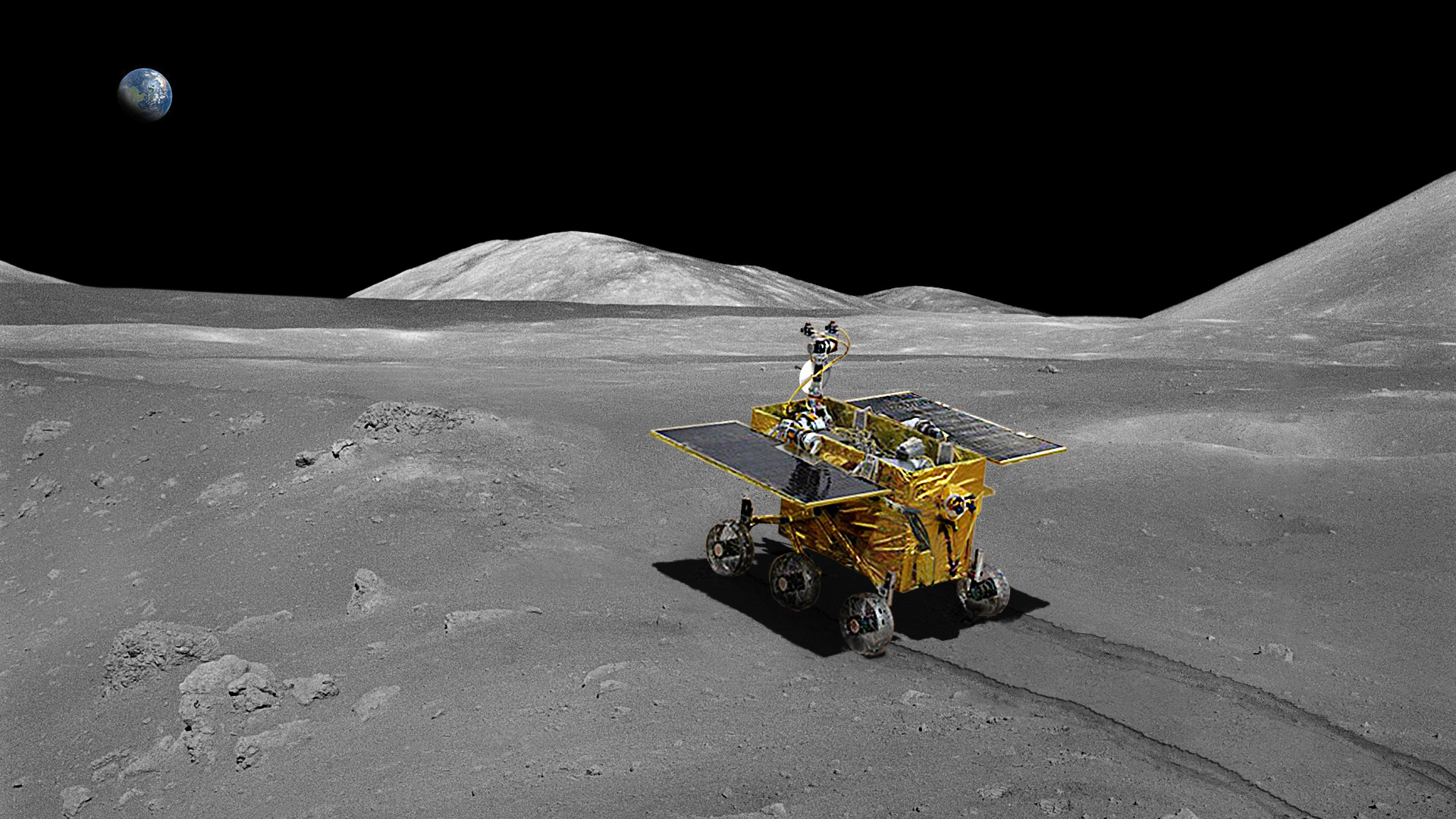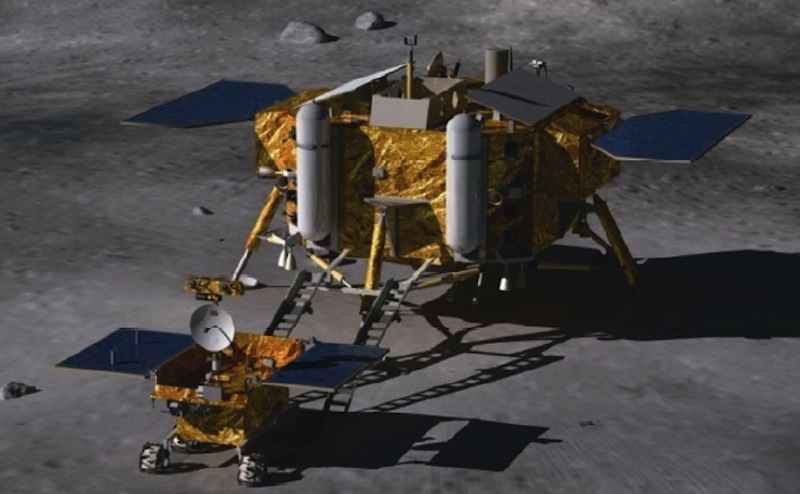Under a China Moon: The Politics of Cooperation in Space


Update for Dec. 14: China's Chang'e 3 spacecraft has successfully landed on the moon. Read the full story here: China Lands On The Moon: Historic Robotic Lunar Landing Includes 1st Chinese Rover
China may soon become the third nation to soft-land robotic hardware on the moon.
This weekend, the Chang'e 3 lander is set to ease down from lunar orbit and autopilot safely onto the barren moonscape calledSinus Iridum, a plain of basaltic lava. Once on location, the lander will deploy the Yutu rover with both sets of hardware fully geared to conduct scientific exploration on the moon for months.
NASA has been mum on China's moon ambitions. The space agency ended its human visits to the moon in 1972. [See photos from China's Chang'e 3 moon landing and rover mission]
So as China's lunar craft silhouettes itself across the landing zone, perhaps it's fitting for the U.S. space agency to strike up that 1970s tune by songwriter Yusuf Islam, formerly Cat Stevens: "Yes, I'm being followed by a moonshadow, moonshadow, moonshadow."
China's moon assist from Europe
The European Space Agency's European Space Operations Centre (ESOC) in Darmstadt, Germany, is assisting China in getting Chang'e 3 to the moon and then down onto the lunar landscape.
Breaking space news, the latest updates on rocket launches, skywatching events and more!
"ESOC support for the Chang'e-3 lunar landing, which is currently scheduled for Saturday, Dec. 14 in the afternoon, will initially be during the powered lunar descent phase, where the ESA Deep Space terminal in New Norcia, Western Australia, will measure the Doppler shift as a secondary station," Erik Soerensen, head of the ground facilities external services section at ESOC, wrote in an email to SPACE.com.
"The landing and rover operations on the moon will be commanded via two Chinese tracking stations at Kashi, in the far West of China, and at Jiamusi, in the Northeast," Soerensen added. The New Norcia station, he said, will also record the Chang'e-3's radio signals during descent and landing, which will help the Chinese to reconstruct the trajectory for future reference.
After the lander and rover are on the surface, Soerensen said, the New Norcia stations will be complemented with the ESA Deep Space station in Cebreros, west of Madrid, Spain, to provide Delta Differential One-way Range (Delta-DOR) interferometry — an array of instruments that act together to provide higher resolution accuracy — and position determination of the Chang'e 3 lander. [10 Surprising Facts about the Moon]
"With Delta-DOR technology, one can compute locations with extreme accuracy," Soerensen said.
Human rights
ESA's involvement in the Chang'e 3 mission is in stark contrast with NASA's hushed tone — and politics may be at play.
According to SPACE.com sources, the space agency's civil servants have been made aware of the sensitive nature of the U.S. government's dealings with China. These civil servants have been asked to be guarded in their comments about China's space projects, as any remarks could be construed as NASA or overall government policy.
This reluctance to discuss China's space agenda appears to be tied to Rep. Frank Wolf, R-Va., chairman of the House Appropriations Committee's Subcommittee on Commerce, Justice, Science and Related Agencies, whose jurisdiction includes NASA. Wolf is also co-chairman of the House's bipartisan Human Rights Commission and strictly opposes cooperation with Chinese-government-funded agencies and programs, he has stated, due to China's systemic human-rights abuses.
Cooperation with China
As reported by Marcia Smith, founder and editor of SpacePolicyOnline.com, Wolf is one of Congress' strongest critics of the Chinese government. The legislator included a provision in law prohibiting NASA and the White House Office of Science and Technology Policy (OSTP) from spending any appropriated funds on anything related to space cooperation with China.
By public law, neither NASA nor OSTP may "develop, design, plan, promulgate, implement or execute a bilateral policy, program, order or contract of any kind to participate, collaborate or coordinate bilaterally in any way with China or any Chinese-owned company," including "the hosting of official Chinese visitors at facilities belonging to or utilized by NASA."
The only exceptions are if the activity is specifically authorized by Congress or NASA, or if OSTP certifies to Congress 14 days in advance that the activity will not result in the transfer of "technology, data or other information with national security or economic security implications to China or a Chinese-owned company," Smith posted on the website.
When asked how best to work with the Chinese, Clive Neal, a leading lunar scientist at the University of Notre Dame's Department of Civil and Environmental Engineering and Earth Sciences, responded: "That's a tough one."
"I think that collaborations between U.S. and Chinese lunar scientists is OK, as long as no NASA grant money is expended, unless the rules have recently changed," Neal told SPACE.com. "Passing along information in an open forum is also OK. However, after that, my knowledge gets a little murky."
But, Neal said, one thing is clear: The "political wrangling is holding back both science and exploration of the moon, and is frustrating quite a few voters here in the United States.”
Level of sharing
Meanwhile, the U.S. space-science community appears eager to benefit from Chang'e 3's lunar findings.
"I have been surprised and pleased at how the Chinese have been very open about the Chang'e 3 spacecraft and its mission," said Stephen Mackwell, director of the Lunar and Planetary Institute in Houston. "Through the Web and interactions with Chinese scientists, we have been provided with unprecedented information on the lander and rover, as well as the timing of mission and landing site information."
Mackwell told SPACE.com that he hopes this level of sharing will continue with the timely release of the science data from the Chang'e 3 and China's future planned robotic missions.
NASA statement: new scientific opportunity
Just prior to China’s deep dive onto the moon on Saturday, the up-to-now quiet official view from NASA of the Chinese mission was issued late Friday.
"China's lunar lander may provide additional science for NASA spacecraft." NASA said. "Scientists using four NASA spacecraft currently studying our lunar neighbor may get an opportunity to gather new data from the expected December 14 landing of the Chang'e 3 lunar rover. U.S. and international researchers view the pending arrival as a new scientific opportunity that could potentially enhance studies and observations of the lunar atmosphere," according to a NASA statement.
China's robotic lander will arrive as NASA's Lunar Atmosphere and Dust Environment Explorer (LADEE), Lunar Reconnaissance Orbiter (LRO), and two probes called the Acceleration, Reconnection, Turbulence and Electrodynamics of Moon's Interaction with the Sun (ARTEMIS) continue their science missions," the NASA statement explains.
"Although there is no cooperation between the U.S. and China on these missions, U.S. researchers could see potentially interesting science from the landing. The data will be made available to the international science community." according to the NASA press statement.
'Prudent and wise'
Despite the U.S.-China cooperation angst, there could be ways of working together.
"While NASA is restricted from bilateral interactions with China, recent indications suggest that multilateral discussions that include China and NASA, among other spacefaring nations, are allowable,” Mackwell said.
Because the moon is the current target of choice for many spacefaring nations, Mackwell said, "it would seem both prudent and wise" for all lunar space programs to interact, and a multilateral setting might ultimately be the best environment. [Photos from Chang'e 3's launch to the moon]
In this way, Mackwell said, "all nations interested in lunar missions — be they orbiters, landers, rovers and sample return — interact early and often in order to maximize scientific return and minimize unnecessary duplication of effort."
Mackwell said that "a great example of such interactions" would be the sharing of Chinese data on the detailed chemistry of the propellant that the Chinese will use as Chang'e 3 transitions from lunar orbit to the moon's surface.
Doing so, Mackwell said, would help NASA measurements of the consequent evolution of the lunar exosphere using the moon-orbiting Lunar Atmosphere and Dust Environment Explorer (LADEE) spacecraft.
A central goal of NASA's LADEE mission is to study the moon's thin exosphere and the lunar dust environment.
"There is so much to be gained by openly sharing planetary data between nations, especially given the high cost of planetary missions," Mackwell said.
Robust science plan
David Kring, senior staff scientist at the Lunar and Planetary Institute, noted that China has embarked on an ambitious lunar exploration campaign that has already met two successful milestones: the orbital insertion of the Chang'e 1 spacecraft in November 2007, and detailed orbital measurements made from Chang'e 2 in 2010 and 2011.
If successful, the Chang'e 3 lunar lander and rover will be the first soft landing of a vehicle on the moon in more than 40 years and will provide China "with a capability that no other nation currently has," Kring told SPACE.com.
The Chinese moon mission has a robust science plan for the exploration of the impact-cratered basaltic flood plains of Sinus Iridum, Kring said.
"If Chang'e 3 is successful, China will likely press ahead with its plans for other robotic missions, including a sample return mission by 2020, human precursor missions [during] 2021-2025 and a human landing [sometime between] 2025 [and] 2030," Kring said. "China has further stipulated that its long-term plan is to develop lunar outposts and human settlements on the lunar surface."
Visit SPACE.com for the latest news on China's space missions and the Chang'e 3 moon landing.
Editor's note: This story was updated at 6 a.m. on Dec. 14 to include new comments from NASA on China's first moon landing mission.
Leonard David has been reporting on the space industry for more than five decades. He is former director of research for the National Commission on Space and is co-author of Buzz Aldrin's new book, "Mission to Mars – My Vision for Space Exploration," published by National Geographic. Follow us @Spacedotcom, Facebook and Google+. Original article on SPACE.com.

Leonard David is an award-winning space journalist who has been reporting on space activities for more than 50 years. Currently writing as Space.com's Space Insider Columnist among his other projects, Leonard has authored numerous books on space exploration, Mars missions and more, with his latest being "Moon Rush: The New Space Race" published in 2019 by National Geographic. He also wrote "Mars: Our Future on the Red Planet" released in 2016 by National Geographic. Leonard has served as a correspondent for SpaceNews, Scientific American and Aerospace America for the AIAA. He has received many awards, including the first Ordway Award for Sustained Excellence in Spaceflight History in 2015 at the AAS Wernher von Braun Memorial Symposium. You can find out Leonard's latest project at his website and on Twitter.




